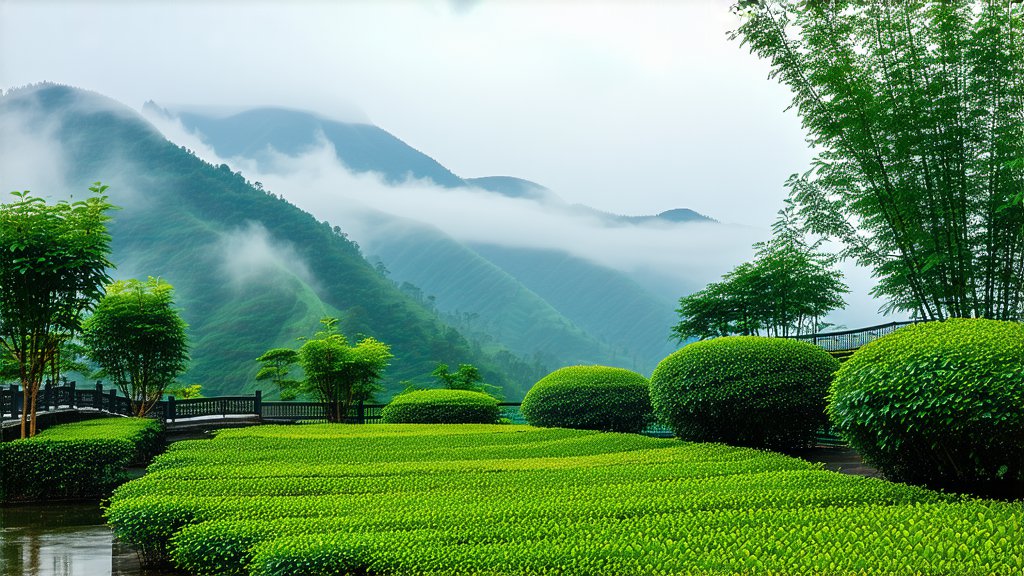
In the verdant hills of Anxi County, nestled within the lush landscapes of Fujian province in southeastern China, lies a treasure revered by tea connoisseurs worldwide—Tieguanyin, often referred to as the "Iron Goddess of Merchandise." This exquisite variety of Chinese oolong tea has captivated palates for centuries with its intricate flavor profile and aromatic allure. As we embark on a journey through its storied past, diverse classifications, meticulous production process, and nuanced tasting techniques, one cannot help but be enchanted by the depth and complexity that define this remarkable beverage.
Historical Roots and Legendary Beginnings
The origins of Tieguanyin can be traced back to the early 18th century during the Qing Dynasty. According to local folklore, the tea was discovered by Wei Yin, a poor scholar who stumbled upon an ancient camellia plant while seeking respite from his studies. Intrigued by its unique properties, he propagated cuttings from this mysterious tree, which bore leaves that produced an exceptionally fragrant and flavorful infusion. The name 'Tieguanyin,' meaning "Iron Buddha," was later bestowed upon this tea, symbolizing its enduring strength and divine essence. Over time, Tieguanyin gained prominence not only as a cherished local delicacy but also as a symbol of Chinese cultural heritage and sophistication.
A Symphony of Varieties
Tieguanyin encompasses several distinct sub-varieties, each with its own unique characteristics and appeal. Among them, the most celebrated include:
- Traditional Tieguanyin: Known for its robust body and pronounced orchid-like fragrance, this classic variant embodies the quintessential qualities of the tea. Its leaves are tightly rolled and possess a deep green hue when freshly plucked.
- Fragrance Type Tieguanyin: This category emphasizes the floral notes inherent in the tea, with some cultivars exhibiting hints of magnolia, jasmine, or even fruity undertones. The processing methods employed play a crucial role in enhancing these subtle yet enchanting aromas.
- Dragon Ball Tieguanyin: Hand-rolled into small, spherical shapes resembling dragon balls, this type offers a visually striking appearance alongside its rich taste. The rolling process contributes to a slower unfurling during steeping, allowing for multiple infusions without compromising flavor.
The Art of Crafting Tieguanyin
The creation of Tieguanyin involves a series of meticulous steps designed to preserve the integrity and enhance the natural flavors of the tea leaves. Here's an overview of the traditional manufacturing process:
- Plucking: Selective handpicking ensures only the finest young shoots and leaves are harvested, usually during the spring and autumn seasons when the climate conditions are optimal for growth.
- Withering: Freshly picked leaves undergo a gentle withering process, either spread out under the sun or indoors using controlled temperature and humidity. This step reduces moisture content and initiates enzymatic activity.
- Bruising: The withered leaves are then gently tossed in bamboo baskets or shaken in specialized machines to bruise the edges slightly. This action releases enzymes that facilitate oxidation while preserving the green color of the leaves.
- Fixation (Pan-frying): To halt enzymatic action and fix the desired level of oxidation, the leaves are quickly pan-fried in woks at high temperatures. This step imparts a distinctive roasty aroma to the tea.
- Rolling: After fixation, the leaves are rolled into tight coils or spheres, depending on the intended style. This shaping process helps concentrate flavors and prepares the leaves for drying.
- Drying: Finally, the shaped leaves are dried thoroughly to remove any remaining moisture, ensuring longevity and stability of the finished product.
Savoring the Essence: Tasting Techniques
To fully appreciate the nuances of Tieguanyin, it is essential to follow proper tea tasting rituals. Here are some guidelines to elevate your sensory experience:
- Preparation: Use a Yixing clay teapot or a Gaiwan (a lidded bowl) made of porcelain or glass to allow for better visualization of the leaves. Rinse the vessel with hot water before adding the tea.
- Water Quality: Employ fresh, filtered water heated to approximately 95°C (203°F). The purity and mineral content of water significantly impact the taste of the brew.
- Measurement: For every 150ml of water, use about 5 grams of loose leaf tea or adjust according to personal preference. Oversteeping may lead to bitterness, so start with shorter infusion times (around 30 seconds) and gradually increase as needed.
- Observation: Admire the unfurling of tea leaves as they dance gracefully in the hot water, releasing their vibrant colors and enticing aroma. Note the clarity and color intensity of the liquor.
- Smell: Inhale deeply to capture the complex bouquet wafting from the brewed tea. Detect subtle changes in fragrance with each subsequent infusion.
- Tasting: Take small sips, allowing the liquid to coat your entire mouth before swallowing. Pay attention to the balance between sweetness, bitterness, astringency, and umami flavors. Savor the aftertaste that lingers on your palate.
- Multiple Infusions: Tieguanyin is known for its ability to withstand multiple infusions, each revealing new dimensions of flavor. Experiment with varying steep times to explore the full spectrum of its character.
In conclusion, Tieguanyin stands as a testament to China's rich tea heritage and the artistry involved in its cultivation and preparation. From its mythical beginnings to its modern-day status as a global icon of fine tea, this extraordinary oolong continues to inspire admiration and delight among tea enthusiasts worldwide. Whether you're a seasoned aficionado or a curious novice, embarking on a journey with Tieguanyin promises an unforgettable encounter with one of nature's most exquisite gifts.